Running a successful ecommerce store isn’t just about having great products or a sleek design.
If your store doesn’t appear in search, most shoppers will never know it exists.
That’s where ecommerce SEO comes in.
It’s what connects your store to the right kind of traffic, from visitors who buy products.
I’ve helped ecommerce brands grow significantly through focused SEO strategies, seeing results like a 300% increase in organic clicks.
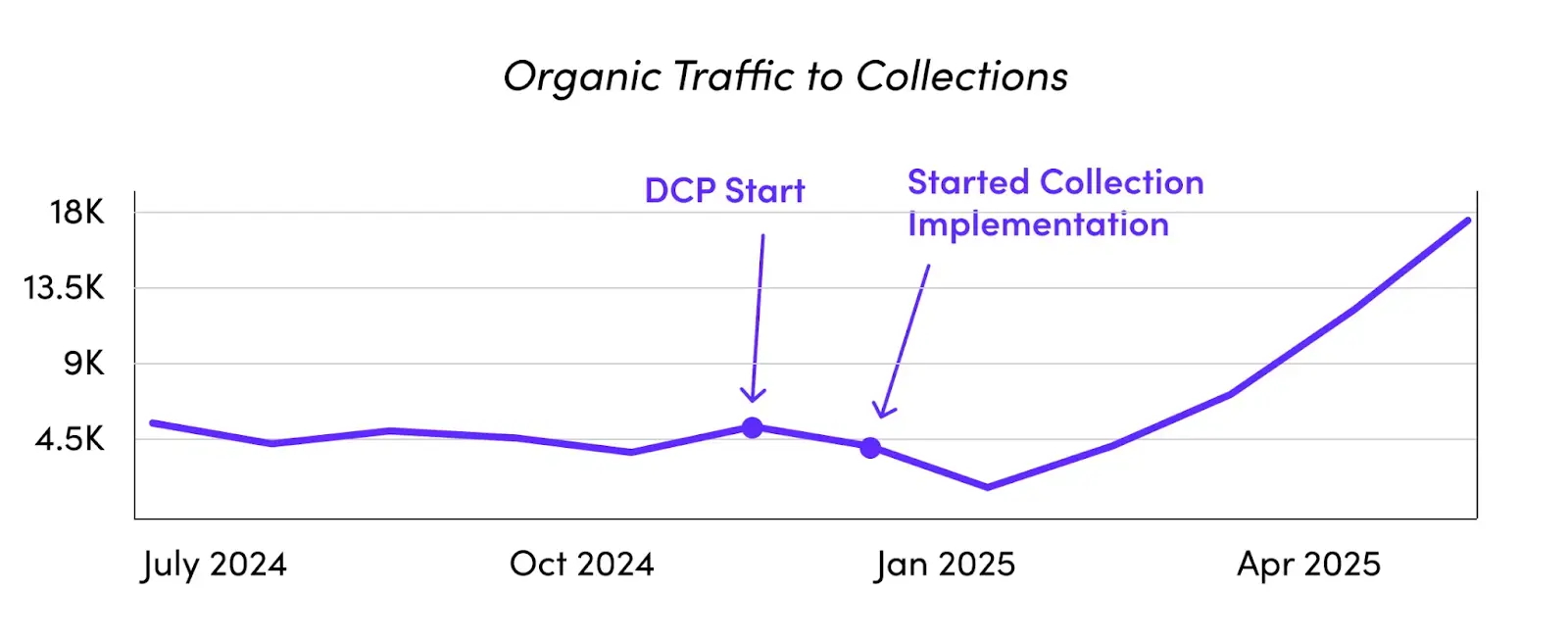
In this guide, I’ll walk you through the same proven techniques, covering everything from technical SEO and keyword research to content strategy and site structure.
By the end of this ecommerce SEO guide, you’ll know exactly how to optimize your product and category pages, build a search-friendly site structure, fix common SEO issues, and tap into high-intent search traffic that buys.
Search is Changing. Is Your SEO Ready?
We specialize in reversing traffic drops and navigating search instability for profitable companies in competitive markets. Click below to learn about our award-winning SEO services.
Table of Contents
What Is Ecommerce SEO?
Ecommerce SEO is the process of optimizing your online store so that it shows up in search engines like Google when people are looking to buy the products you sell.
Unlike traditional SEO, which often focuses on blog content or service pages, ecommerce SEO is laser-focused on driving traffic to product and category pages, the pages most likely to generate sales.
At a high level, this means:
- Structuring your site for search crawlers
- Writing high-converting product descriptions
- Fixing technical issues that block visibility
A strong ecommerce SEO strategy reduces your reliance on paid ads and helps you build a consistent stream of traffic from customers who are actively searching for what you offer. Done right, it turns your website into a customer acquisition machine.
Here’s the core difference:
- Service businesses compete on trust or expertise
- Ecommerce businesses compete on selection, product relevance, and user experience
Search engines, and increasingly AI models like LLMs, look at many of the same fundamentals that drive ecommerce success. They evaluate:
- How your store is structured
- How fast it loads
- How unique your content is
- How easy it is for shoppers to find and purchase products
This overlap has become even more important recently.
With the rise of AI-powered search features like Google’s AI Overviews and platforms such as ChatGPT and Perplexity, more customers are discovering products directly through LLM-generated answers.
These models don’t replace search engines; they depend on them. They crawl, index, and cite websites as their source material.
For ecommerce brands, this means:
- Visibility goes beyond the SERP. Your product and category pages need to be optimized to show up not just in organic rankings, but also as cited references in AI answers.
- Authority is critical. LLMs are more likely to surface sites with strong topical coverage, clean technical foundations, and trustworthy signals.
- Optimization compounds. The same SEO work that boosts rankings also increases your chance of being recognized as a reliable source by LLMs.
In short, ecommerce SEO isn’t just about ranking in search anymore.
It’s about positioning your store to be discoverable and cited in both traditional search results and AI-driven experiences that millions of shoppers are already using.
Want to rank and convert? You need to do more than sprinkle keywords across your homepage.
You need a strategy that spans product metadata, technical fixes, smart content, and ongoing optimization.
We’ll cover all of that and more in the sections ahead.
Understanding How SEO Works for an Ecommerce Website
Ecommerce SEO isn’t just traditional SEO applied to a store; it has its own rules, structure, and stakes.
Site structure matters. A messy, shallow structure confuses search engines. You want a clear hierarchy: homepage → category → subcategory → product. This not only helps Google crawl and index your site but also makes for a better shopping experience.
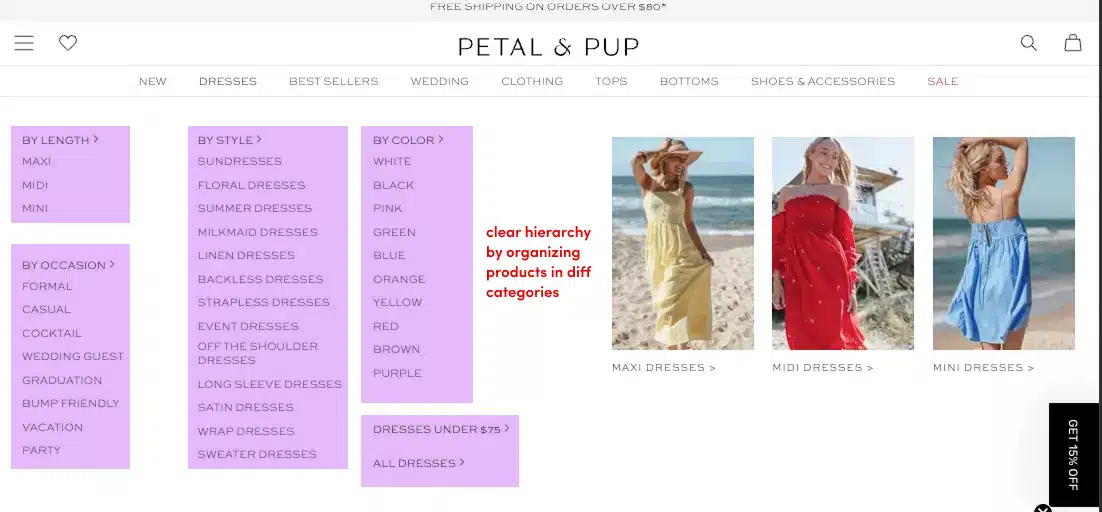
This is a strong example of ecommerce SEO best practices done right. An effective ecommerce SEO homepage flows into a main category (“Dresses”), then into clearly defined subcategories like “By Length,” “By Style,” and “By Occasion.” This structure not only improves crawlability for search engines but also simplifies navigation for users
Product pages aren’t “thin” pages. Each product should include unique, keyword-relevant descriptions, high-quality images, reviews, and schema markup. Think of each product page as a mini landing page.

The use of high-quality images, clear model specs, and expanded sections like “Fabric & Care” and “Shipping & Returns” gives customers the confidence to buy without crowding the page. This balance of rich content and structured layout not only supports conversion but also gives search engines more to work with.
Category pages are your real SEO powerhouses. These are the pages that often rank best for high-volume, high-intent searches like “men’s running shoes” or “organic dog food.” Optimizing these with keyword-rich copy, internal links, and a clear UX can drive massive results. See our full guide on ecommerce category page SEO.
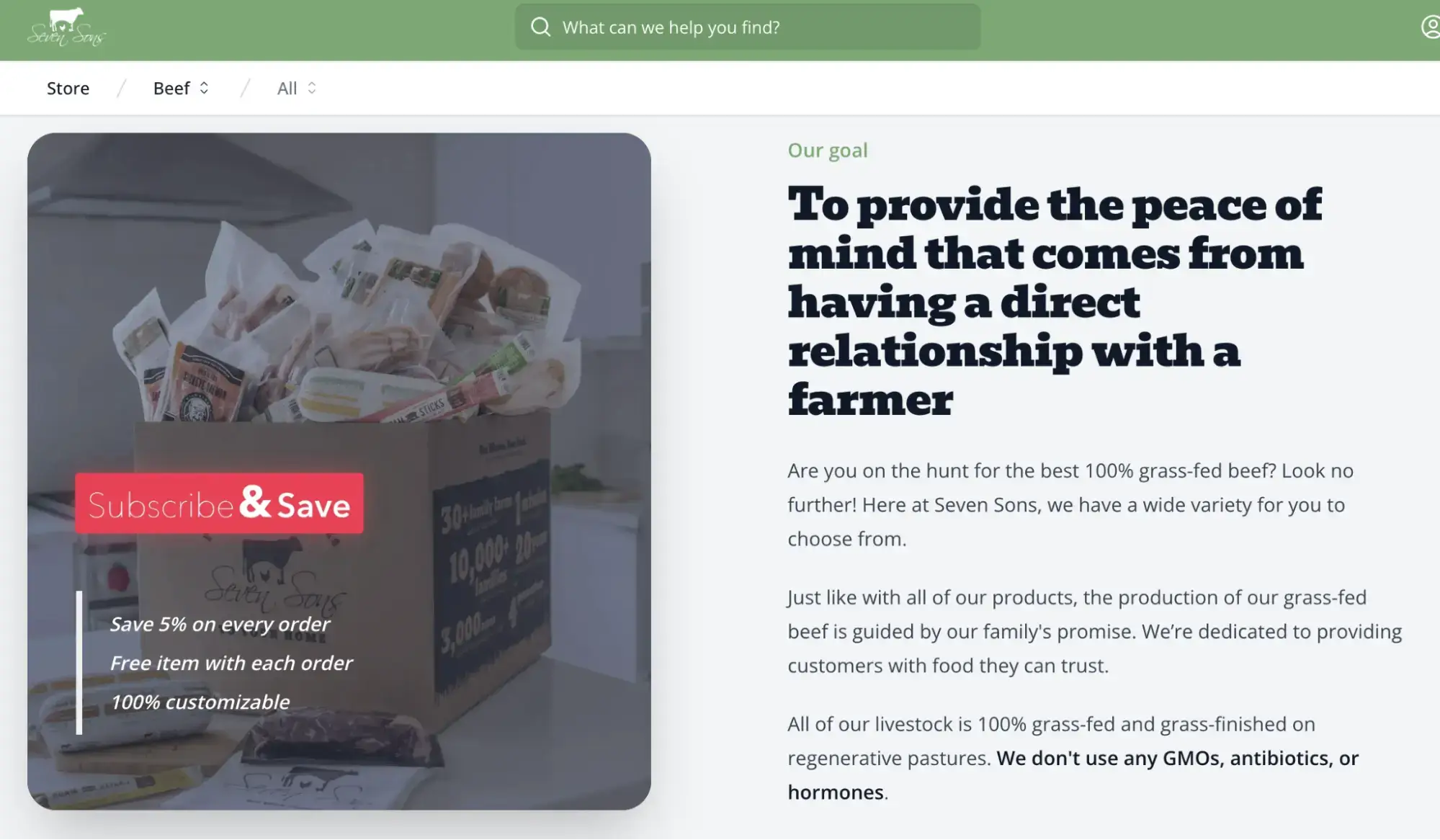
Seven Sons’ grass-fed beef collection page combines trust signals with a clear brand message and an integrated “Subscribe & Save” offer. The result is a page that ranks well for terms like “grass-fed beef” while guiding shoppers toward action.
Technical factors like page speed, mobile usability, and structured data also play a huge role.
If your site takes forever to load or isn’t mobile-friendly, you’re likely losing traffic and conversions, regardless of how well your content is optimized.
In short, SEO for ecommerce websites is a blend of content marketing, architecture, and tech, all tailored to product discovery and user experience.
Keyword Research for Ecommerce Websites
Finding the right keywords is the foundation of ecommerce SEO.
You’re not just looking for traffic, you’re looking for buying intent. And that starts with understanding what your ideal customer is searching for when they’re ready to shop.
Tools like Google Keyword Planner, Ahrefs, and Semrush can help you uncover high-intent keywords that align with your product offerings. But research alone isn’t enough; you need to map those keywords effectively and apply them where they’ll have the most impact.
Let’s dive into the three steps that make this process work.
Finding the Right Keywords for Product and Category Pages
When optimizing ecommerce sites, you need keywords that match purchase intent.
Informational keywords like “how to style wide-leg jeans” are great for blog content, but your category page needs to target terms like “women’s wide-leg jeans” or “high-waisted wide-leg denim.”
Here’s a simple workflow to find the right keywords for your product and category pages:
- Start with a seed keyword. Think of a basic product descriptor like “pajama sets” or “men’s dress shoes.”
- Plug it into a tool like Ahrefs or Semrush. Use the keyword explorer to find long-tail variations that include intent-based modifiers like “best,” “buy,” “affordable,” or specific materials and fits.
- Filter for purchase intent. Look for terms with commercial or transactional intent, keywords people use when they’re closer to buying.
- Sort by keyword difficulty and volume. Aim for a balance: terms that get meaningful traffic but aren’t overly competitive.
- Cross-reference competitor rankings. Use the “Content Gap” tool (Ahrefs) or “Keyword Gap” (Semrush) to find terms your competitors rank for but you don’t.
These not only signal strong buying intent, but also give you opportunities to optimize content on your collection pages. Some additional tips as you refine your keyword list:
- Long-tail phrases with buying intent. These often include modifiers like “best,” “affordable,” “buy,” or specific product details like size, color, and material.
- High volume, low difficulty (where possible). Use Ahrefs or Semrush to spot keywords your competitors are ranking for but you aren’t.
- Synonyms and variations. Think like a shopper, someone might search for “running shoes,” “trainers,” or “athletic sneakers.” Cover them all where it makes sense.
Category pages should include a few short paragraphs of SEO-optimized content that naturally include these terms, without overstuffing.
Product pages should include the most relevant keywords in the product name, description, alt text, and metadata.
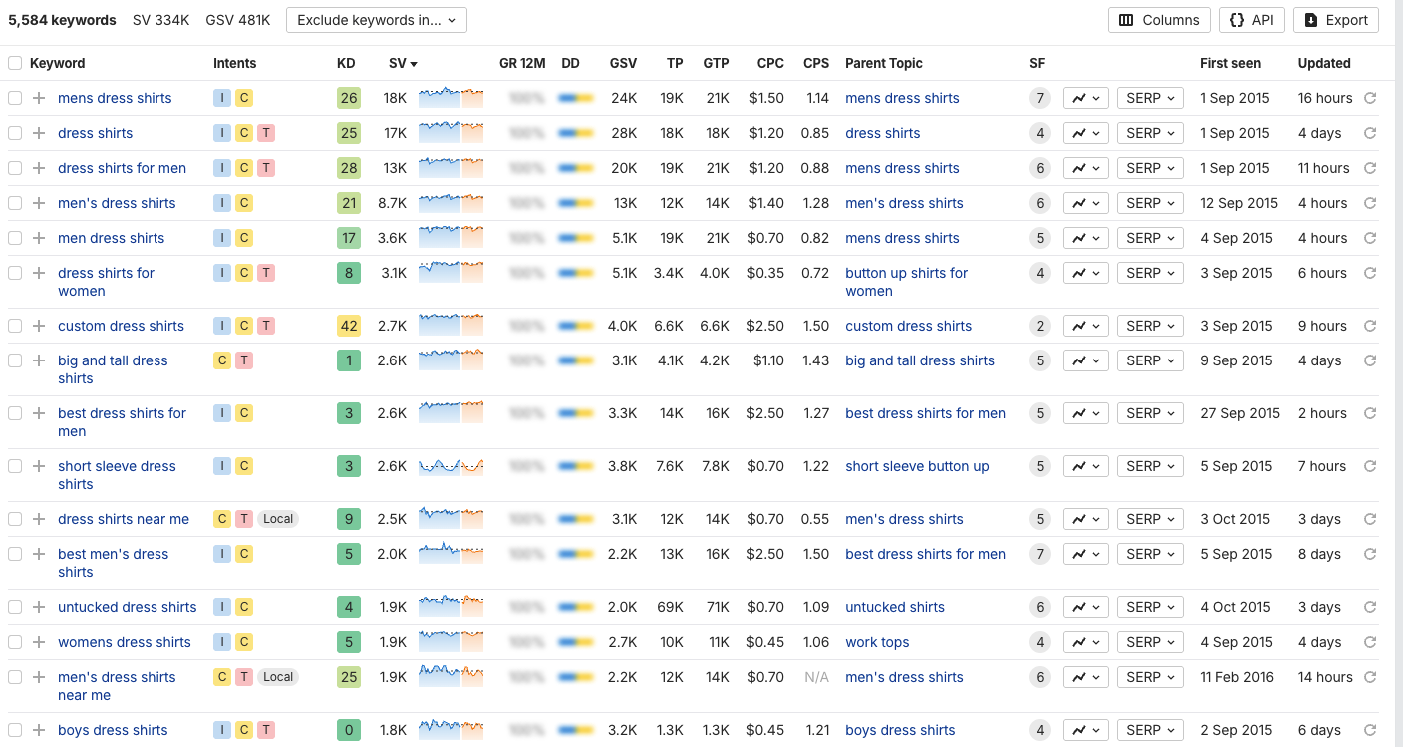
As shown in the example above, keyword tools like Ahrefs let you quickly identify long-tail, high-intent phrases with solid search volume.
Phrases like “custom dress shirts” or “best men’s dress shirts” have a clear purchase intent and can be strategically used across product titles, category intro copy, and metadata.
Competitor Keyword Research
One of the most effective ways to build your ecommerce keyword strategy is by analyzing what’s already working for your competitors.
Tools like Ahrefs and Semrush can quickly show you which pages and keywords are driving traffic, and where the gaps are in your own site.
Here’s a step-by-step workflow to uncover valuable keyword opportunities:
1. Start with a Competitor’s Domain
Plug a competitor’s website into Ahrefs’ Site Explorer or Semrush’s Domain Overview tool. Choose a brand that ranks well in your niche or sells a similar product line.
2. Analyze Top-Performing Pages
Navigate to the Top Pages report. This shows which URLs bring in the most organic traffic.
Ask:
Do they have category pages you don’t?
Are their best pages product pages, collections, or guides?
Are they ranking for seasonal or evergreen topics?
Take notes on the types of pages that work well and how they’re structured.
3. Pull Their Top Organic Keywords
Next, go to the Organic Keywords report to see what terms those pages rank for. Sort by traffic or position to find keywords that:
- Indicate strong buying intent
- Include modifiers like “buy,” “best,” or product specs
Target variations of your seed keywords
Log these in a spreadsheet, grouped by intent or page type (e.g., category vs. product).
4. Run a Keyword Gap Report
Now switch over to Content Gap (Ahrefs) or Keyword Gap (Semrush). Enter your domain and your competitors’ to identify:
- Keywords they rank for, but you don’t
- Ranking gaps in specific product verticals
- Terms where you’re not on page 1, but they are
This is a goldmine for missed opportunities.
5. Look for Patterns in Site Structure
Pay attention to how competitors organize their keyword targets:
- Do they split pages by fit (e.g., “petite maxi dresses” vs. “plus-size maxi dresses”)?
- Do they create landing pages for seasonal trends like “beach pajamas” or “wedding guest dresses”?
- Are there geo-specific pages (e.g., “linen shirts Canada”)?
These insights can inform your collection strategy, page creation roadmap, and internal linking plan.
Keyword Mapping for Ecommerce at Scale
Once you’ve done your keyword research, the real magic happens when you map those keywords to specific pages on your site.
Keyword mapping is how you avoid overlap, fill gaps, and build a site that ranks intentionally, not accidentally.
In ecommerce, this step is even more important because you’re often working with hundreds of product pages, collections, and supporting content.
Without a solid map, you’ll end up with cannibalization, thin pages, and missed opportunities.
Here’s how to do it right.
Build a Scalable Keyword Map
Start with a spreadsheet or a database, something you can sort, filter, and expand easily. Your structure might look like this:
| Page Type | URL | Target Keyword | Supporting Keywords | Notes |
| Category Page | /womens-pajama-sets | womens pajama sets | cotton pajama sets, matching sleepwear | Needs intro paragraph |
| Product Page | /products/satin-lilac-set | satin pajama set | lilac pajamas, silky pajamas for women | Title tag missing |
| Blog Post | /blog/best-summer-pajamas | best summer pajamas | lightweight sleepwear, breathable pajamas | Link to Summer Sets |
Do this across every major category and product line. You’re not just assigning keywords, you’re designing how your entire site interacts with search engines.
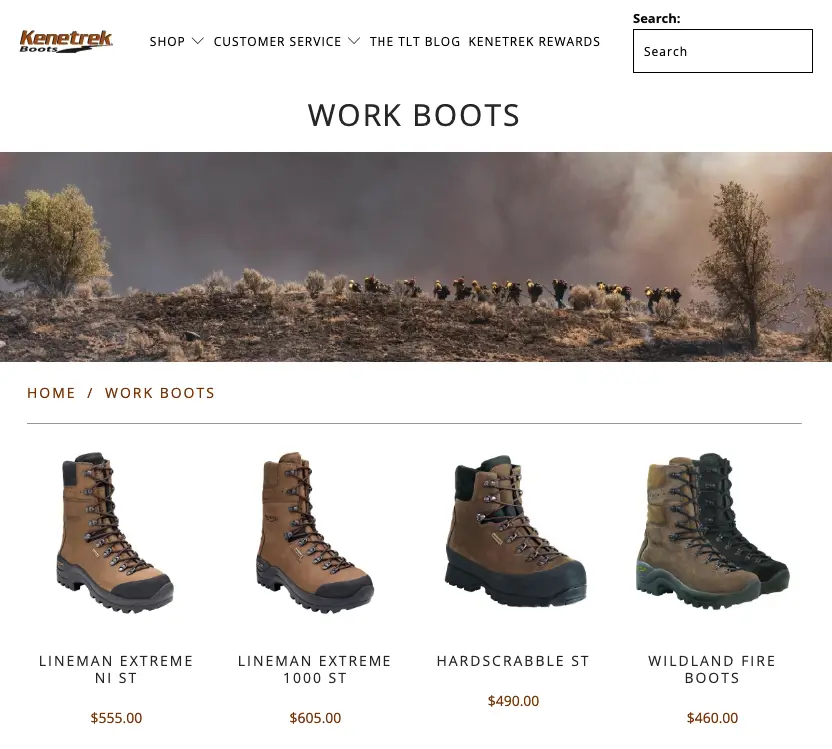
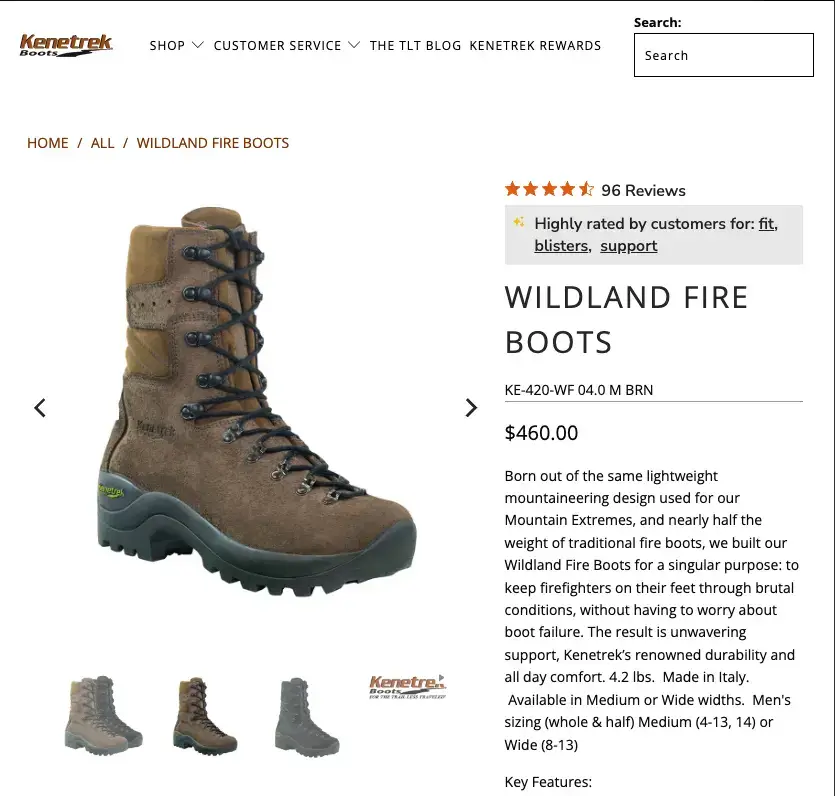
Each page on your ecommerce site should have a clear keyword purpose. For example, a category page like the one above might target “work boots” and sub-keywords like “lineman boots” or “fire boots.”
The product page, in contrast, should target a specific term like “wildland fire boots” with variants or descriptive modifiers used naturally in the copy.
Over time, your keyword map becomes the blueprint for your content strategy, internal linking, and on-page optimization.
This isn’t just guesswork—we’ve done this for countless clients. Learn how our keyword mapping framework helped a DTC brand jump from zero to 27 of their 47 priority keywords ranking on page one in just six months. See the full results in our Discreet Brand, Loud Results case study.
Avoid Keyword Cannibalization
One of the biggest issues in ecommerce SEO is having multiple pages compete for the same term. For example, both your “Pajama Sets” collection and a blog post called “Best Pajama Sets” might be trying to rank for the same keyword.
To prevent this:
- Choose a primary page for each core keyword
- Use internal linking to support that hierarchy
- Use variations (e.g., “luxury pajama sets” vs. “cotton pajama sets”) to target secondary pages
Your keyword map becomes the guardrail, showing what belongs where, and what still needs to be built. For a deeper dive into how this works and how to fix it at scale, check out our full guide to keyword cannibalization.
On-Page SEO for Ecommerce
On-page SEO is the part you have the most control over, and where most ecommerce sites miss the mark. When you dial in your titles, descriptions, structure, images, and internal links, you’re not just helping search engines. You’re making it easier for customers to shop, convert, and come back.
Let’s look at the most important elements to get right.
Title Tags and Meta Descriptions
Your title tag is the first impression you make in search results. It’s your billboard. Your invitation. Your hook.
For ecommerce sites, a good title tag should include your target keyword, mention the product or category name, and, where relevant, highlight a unique selling point (e.g., free shipping, organic, handmade).
Example:
Organic Cotton Pajamas for Women | Free Shipping | Cozy & Soft Sleepwear
Meta descriptions don’t directly affect rankings, but they heavily influence click-through rates. Keep them under 160 characters, front-load your primary keyword, and write it like ad copy.
Example:
Shop our cozy, breathable organic cotton pajamas for women—perfect for sleep or lounging. Free shipping on all orders.
Tip: When creating meta descriptions, include action verbs like “Shop now,” “Explore,” “Discover”, and avoid vague phrasing.
Learn how to craft titles that balance SEO and persuasive appeal in our ecommerce titles guide.
Header Tags (H1, H2, H3) and Content Hierarchy
Think of header tags like chapters and subchapters in a book. They structure your content, make it scannable, and signal importance to both users and Google.
Each product or category page should have:
- One H1 (usually the page or collection name)
Multiple H2s (to organize sections like product features, FAQs, reviews, or sizing guides) - H3s under those where needed (to break out bullets or deeper detail)
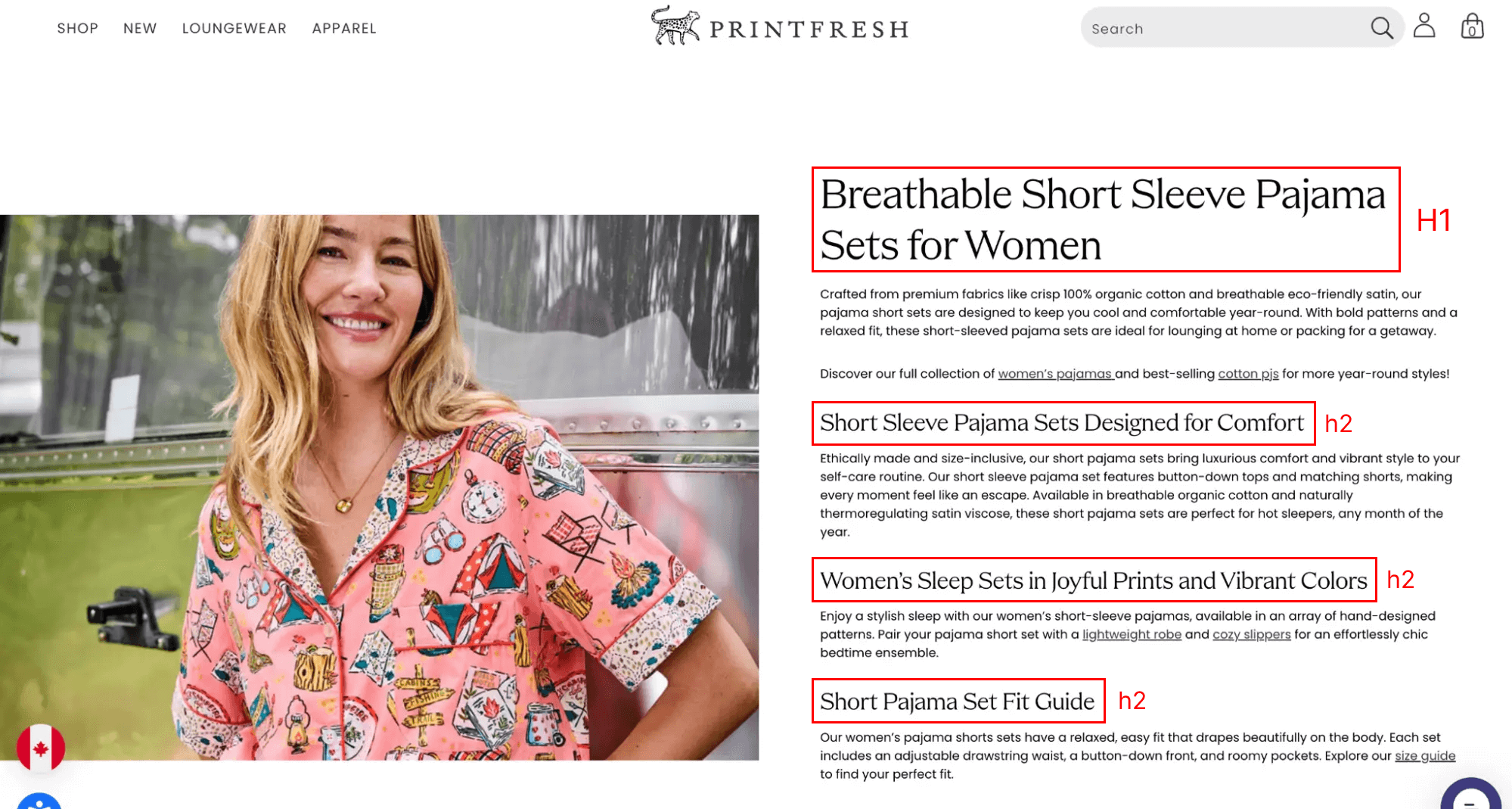
Don’t stuff keywords into every header. One or two well-placed variations are more than enough. Use headers to improve readability and incorporate your target terms naturally.
Product Descriptions That Drive Sales
Product descriptions are often treated as an afterthought, a few generic lines tossed in to check a box. But in ecommerce, they’re one of your most powerful sales tools.
Done well, they not only help your product pages rank in search engines, but they also persuade the right customers to buy.
The biggest mistake store owners make is either using the manufacturer’s boilerplate copy or writing thin, vague blurbs that don’t add anything new.
Neither approach builds trust. Neither differentiates you in a crowded marketplace. And neither will help you win in search.
A compelling product description does three things: it informs, it reassures, and it sells. You want to give the customer a clear sense of what the product is, including materials, fit, features, and benefits, while also helping them imagine how it will look or feel in their daily life.
It should answer the questions they’re likely to have and remove the doubts that might stop them from clicking “Add to Cart.”
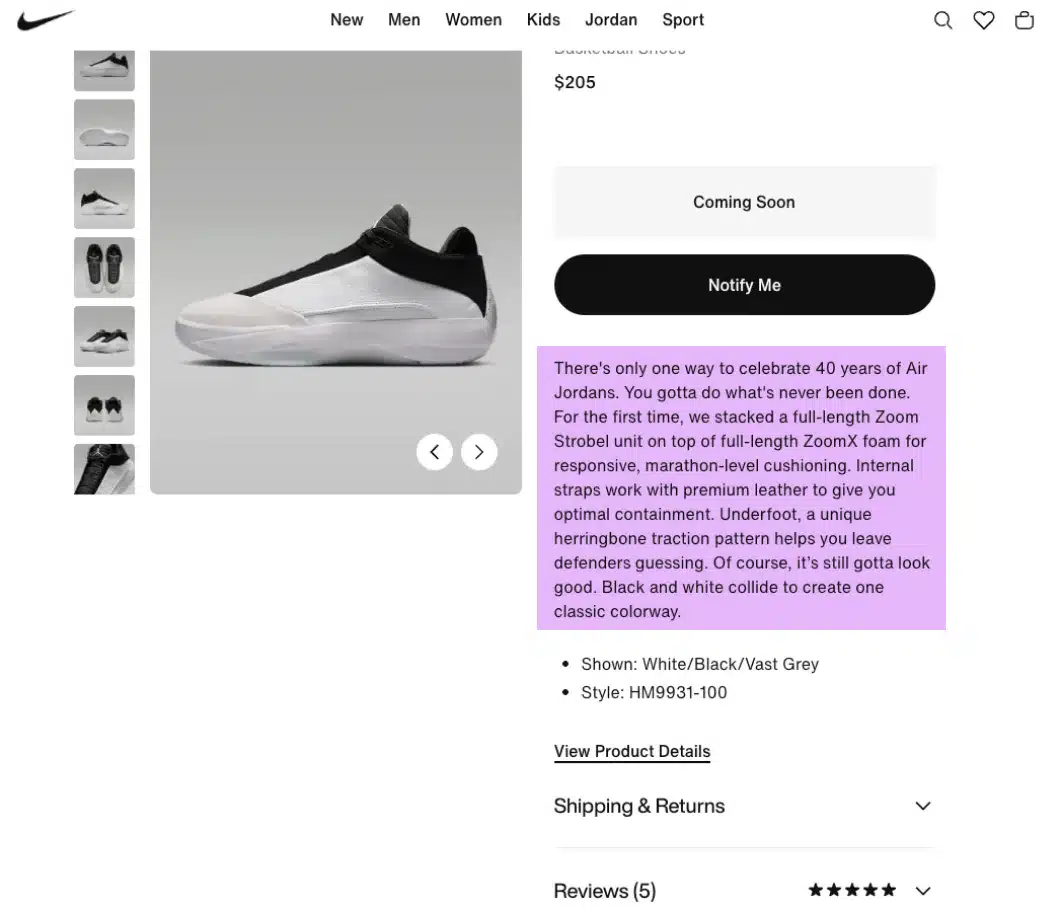
Nike’s product page goes beyond specs; it combines storytelling, technical features, and sensory language to make the customer feel the product’s impact.
Take Nike’s product page, for example (shown above). Instead of a dry list of features, the description leads with a bold narrative: “There’s only one way to celebrate 40 years of Air Jordans. You gotta do what’s never been done.”
It hooks the reader emotionally, then seamlessly blends in technical selling points like “ZoomX foam for marathon-level cushioning” and “internal straps with premium leather.”It informs (materials + specs), reassures (durability + comfort), and sells (legacy + innovation + appearance). That’s the trifecta of a winning product description.
Here’s a quick side-by-side comparison of a frying pan to illustrate the difference:
Before: Durable non-stick frying pan with ergonomic handle. Works on all stovetops. Dishwasher safe.
After: Master every meal with our professional-grade non-stick frying pan, designed for effortless cooking and easy cleanup. Its PFOA-free, scratch-resistant surface lets you flip, sauté, and sear with confidence. No sticking, no stress. Compatible with all stovetops and featuring a cool-touch ergonomic handle, it’s the everyday essential your kitchen’s been craving.
This “After” version taps into the aspiration of better cooking, evokes a sense of ease and quality, and seamlessly incorporates keywords like “non-stick frying pan,” “scratch-resistant,” and “PFOA-free.”
Strong product descriptions should always include:
- Clear and specific details, such as dimensions, fabric, use cases, or ingredients.
- Sensory language that helps customers imagine touch, feel, or lifestyle value.
- Answers to common questions like fit, care, and compatibility.
- Naturally placed keywords for SEO without sounding robotic.
- A reason to buy now, especially if the item solves a problem or meets a need.
Formatting also matters.
Break your copy into short, skimmable chunks. Use subheadings or bold text to emphasize key benefits. Avoid long walls of text; they’re harder to scan and easier to ignore.
Finally, treat each product page like a mini landing page.
Don’t just write for search engines, write for people. Show them why this product is exactly what they’ve been looking for.
Image Optimization for Faster Load Times and Rankings
Images play a huge role in ecommerce SEO, both in rankings and user experience. But they’re often overlooked.
Here’s how to use images correctly:
- Compress all images before uploading. Aim for under 100 KB where possible.
- Use descriptive file names (e.g., organic-womens-linen-shirt.jpg)
- Add alt text that describes the image and includes a keyword if it fits naturally.
- Use WebP format for faster loading (if your platform supports it).
Fast-loading, properly tagged images improve performance metrics and can rank in Google Image search, providing another way to draw eyes to your products.
Internal Linking Strategies
Internal links connect your site’s pages and spread link equity, but more importantly, they help users discover related products, guides, or categories.
Here’s what good internal linking looks like in an online store:
- Category pages link to popular product pages (and vice versa)
- Product pages link to “related items” or product bundles
- Blog posts link to relevant collections and buying guides
- Navigation and footers are structured with SEO in mind
Use a keyword-rich anchor text where it makes sense, but don’t force it. Keep things natural.
Smart internal linking helps Google understand your site’s hierarchy and strengthens the authority of key pages.
As an SEO strategist, I’ve seen firsthand how powerful this can be.
On one project, we implemented a full internal linking audit and restructuring for a sleepwear brand.
By mapping high-value terms to priority pages and redistributing authority more intentionally, we helped the client achieve a 103% year-over-year increase in organic revenue, including 6,000+ new keyword rankings in a single quarter.
Check out our Scaling Sleepwear case study to learn more.
Technical SEO for Ecommerce
You could write the best product descriptions in your niche, but if your site is slow, disorganized, or hard for Google to crawl, none of it will matter.
Technical SEO is the foundation on which everything else sits.
It ensures your store is accessible, indexable, and fast enough to satisfy both search engines and shoppers. Think of it as the plumbing behind the scenes, invisible when working well, painfully obvious when it’s broken.
Site Structure and Navigation
A well-organized ecommerce site structure is intuitive for users and crystal clear to search engines.
The goal? Every product should be reachable in as few clicks as possible, and each page should have a logical place in the overall hierarchy.
Follow the “flat and organized” principle:
- Homepage
→ Category Page
→ Subcategory (optional)
→ Product Page
Good site architecture isn’t just about design—it affects how Google crawls and indexes your pages. A few quick rules:
- Avoid orphan pages: Every page on your site should be linked from at least one other page. If it’s not, Google (and users) may never find it.
- Avoid deep nesting: Don’t bury important pages under multiple subfolders. For example, something like /shop/womens/apparel/tops/new-arrivals/spring-collection/tunic1234 is too long and hard to navigate.
- Use breadcrumbs: These small navigation links (usually near the top of the page) help users move between levels and show search engines how your content is organized.
Clean, Keyword-Rich URLs
Your URLs should be simple, descriptive, and easy for both users and search engines to understand.
Avoid this: /product?id=1234
Use this instead: /mens/running-shoes/nike-air-zoom
Short, keyword-rich URLs look better and improve click-through rates. Further, Google understands the page content more easily.
Mobile Optimization and Core Web Vitals
More than half of ecommerce traffic now comes from mobile devices. If your site doesn’t perform well on mobile, you’re losing traffic, rankings, and revenue.
Start with the basics:
- Use responsive design
- Avoid intrusive popups
- Ensure fonts, buttons, and navigation are mobile-friendly
Next, tackle Core Web Vitals, a set of performance metrics Google uses to gauge UX:
- LCP (Largest Contentful Paint): Measures load speed. Aim for <2.5s.
- FID (First Input Delay): Measures interactivity. Aim for <100ms.
- CLS (Cumulative Layout Shift): Measures visual stability. Aim for <0.1.
Use Google PageSpeed Insights or Lighthouse to audit these. Minor fixes, like deferring scripts or compressing images, can dramatically improve scores and rankings. Specific speed improvement tactics are explained in technical SEO for ecommerce.
Schema Markup for Ecommerce
Schema is structured data that helps Google and other search engines understand the content of your pages more precisely.
Instead of guessing whether your page is about a product, a recipe, or an FAQ, schema tells them exactly what they’re looking at and how to display it in the search results.
For ecommerce, the benefits are immediate and visual. Implementing the right schema allows your listings to show:
- Product names and descriptions
- Customer review ratings and star counts
- Price and availability
- Breadcrumb navigation
- Sale or promotional information
These enhanced search snippets, often called rich results, can dramatically improve how your listings stand out on a crowded search page. They also signal to search engines that your site is organized and trustworthy.
There are a few core types of schema you should prioritize for an ecommerce store:
- Product schema, which highlights core details like name, brand, description, price, and stock status
- Review schema, which showcases customer feedback and average star ratings
- Offer schema, which provides sale or pricing information
- Breadcrumb schema, which reinforces your site structure and improves navigability
- FAQ schema, which can enhance supporting blog content or landing pages with common customer questions
Most modern ecommerce platforms offer some level of schema markup out of the box.
Shopify, WooCommerce, and BigCommerce all include basic product schema, and many themes or plugins extend that functionality. But it’s important to audit what’s actually being included and whether it’s working as intended.
The best way to do this is with Google’s Rich Results Test or Schema.org’s validator tool. These tools will show you exactly what schema is present on a given URL and whether it’s correctly implemented. If something is missing or misconfigured, it’s better to catch it early.
Also worth noting: schema isn’t just for products.
You can add structured data to blog posts, videos, and even location-based pages, such as those with physical showrooms or warehouses. Using the Article, Video, or LocalBusiness schema in the right places provides search engines with a clearer understanding of your content and offerings.
While good ecommerce schema won’t compensate for poor content or technical issues, it gives your best-performing pages an edge, especially in competitive categories where SERP real estate matters.
It’s a subtle but strategic upgrade that helps both your visibility and user experience.
Fixing Crawl Errors and Indexing Issues
Crawl errors can quietly sabotage your SEO efforts. If Googlebot can’t access or index your content, that content might as well not exist.
Regularly check Google Search Console for:
- 404 errors or broken links
- Pages blocked by robots.txt or noindex tags
- Server errors (5xx)
- Duplicate or missing meta tags
Use tools like Screaming Frog or Ahrefs Site Audit to run deeper crawls. You’ll uncover redirect chains, canonical tag issues, and internal link problems.
Fixing these issues is less glamorous than writing content, but it often delivers the highest ROI in ecommerce SEO. Learn how to structure URLs for clarity and SEO in our ecommerce URL structures post.
Content Marketing for Ecommerce SEO
You might think content marketing is just for bloggers or B2B brands. But in ecommerce, it’s your secret weapon.
When done right, content marketing helps your store rank for more keywords, attract top-of-funnel traffic, build trust, and support conversions, without relying solely on product or category pages.
It’s not just about writing. It’s about connecting content with commerce.
Here’s how to do it well.
Creating SEO-Optimized Blog Content
Your blog isn’t just a place for company updates or seasonal promotions.
In ecommerce, it’s a key traffic driver, a way to rank for the questions and keywords your customers are searching before they’re ready to buy. Done well, blog content builds trust, supports discovery, and creates internal pathways that point readers to your most valuable products and collections.
What makes blog content effective isn’t volume, it’s precision.
Each post should solve a real problem, align with your keyword strategy, and ultimately move readers closer to a purchase decision.
The best-performing ecommerce blogs follow a simple principle: write content that helps your customer before they become a customer.
That might mean answering a style question, comparing options, giving seasonal recommendations, or helping them choose between similar products.
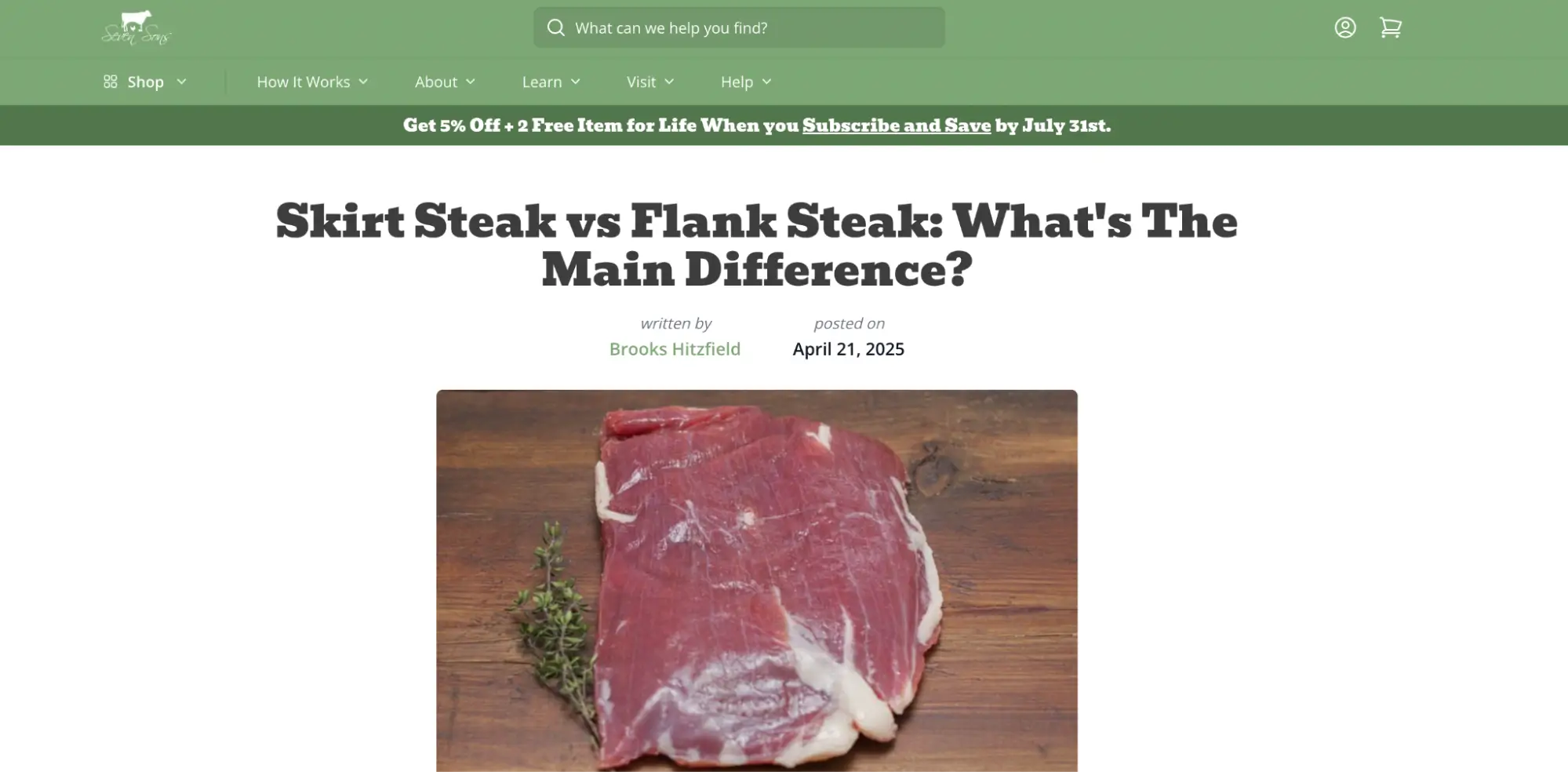
Take this blog post from Seven Sons as an example. It answers a common customer question and supports the buying journey by helping the reader make an informed decision between two similar cuts of meat.
By incorporating clear visuals and structured comparisons, this type of content does double duty: it satisfies search intent and subtly nudges the reader toward exploring related products.
How to Make Every Article Count
Start with search intent. Every blog post should be built around a query your customer might Google.
Look for how-tos, product comparisons, or list-style guides with buyer-focused phrasing. Tools like Ahrefs, Semrush, or even Google’s autocomplete suggestions can help you find untapped content opportunities.
Then, write for clarity and structure. Use:
- Descriptive, keyword-rich titles
- Subheadings (H2s and H3s) to break up the content
- Short paragraphs and bullet lists for scannability
- A natural internal link to a relevant product, collection, or guide
You don’t need to hard-sell. The goal is to lead with value and subtly guide readers toward the next step.
For example, if you’re writing a post about “What to Pack in a Hospital Bag,” it’s natural to link it to your maternity robe collection or nursing pajama sets. That kind of soft CTA fits the reader’s intent and helps SEO at the same time.
Frequency matters less than consistency.
One high-quality, well-optimized blog post per month that supports your keyword map is more valuable than a dozen thin posts no one reads.
Finally, measure performance. Look at organic clicks, rankings, and assisted conversions in Google Search Console and GA4. The best ecommerce blog content doesn’t just drive traffic, it creates future customers.
Off‑Page SEO for Ecommerce
You’ve polished your site’s structure, perfected your content, and tightened up your technical setup. But another key component stands between your store and real authority: how the rest of the web perceives you.
That’s where off-page SEO for ecommerce comes in.
Off-page SEO is about building trust signals, getting external websites to mention, discuss, link to, and promote your ecommerce store.
These signals tell search engines that your site is reputable, authoritative, and worth ranking highly.
Link Building for Ecommerce Websites
Backlinks still matter.
They’re one of the most important ranking signals in SEO. But it’s not just about getting a ton of links. It’s about getting the right links.
For ecommerce brands, that means aiming for backlinks from sources that are relevant, trustworthy, and tied to your industry.
Think of niche blogs that review your products. Online magazines in your space. Partners you work with. Even resource pages that list top ecommerce stores can be a goldmine.
These aren’t just vanity links. They help search engines see your store as an authority and they can drive referral traffic too.
So how do you get them?
One proven method is resource link outreach. This is where you pitch your store as a valuable inclusion in a blog post, guide, or curated directory. For example, if someone’s writing about the best places to buy organic beef online, and that’s what you offer, you should be on that list.
Another great strategy is broken link building. It’s a little technical, but powerful. You find a blog post or page in your niche with a dead link (maybe the company shut down or the URL changed).
Then you offer your own product or content as a replacement. It’s helpful, and it works.
You can also partner with brands that complement yours; maybe they sell seasonings, and you sell meat. Create a shared recipe guide, campaign, or promotion.
You’ll both get exposure, and those links will come naturally through shared content and PR.
Digital PR and Outreach for Backlinks
Earning backlinks from high-authority sites is about credibility. When respected publications mention your brand, it sends trust signals to both users and search engines.
But getting featured isn’t about mass email blasts or generic press releases.
It’s about offering something that feels relevant, useful, or genuinely interesting to a specific audience.
Think Beyond the Pitch
Start with the story.
What makes your brand different? Do you have original research? A fresh perspective on a trend? A surprising customer insight?
Reporters aren’t just looking for products; they’re looking for narratives.
A company that shares seasonal trends backed by internal data, for instance, becomes a helpful source.
Not just another brand asking for coverage.
Even a simple blog post with useful data can spark interest.
Journalists are busy. Make their job easier by doing the research and telling the story for them.
Make It Personal
If you’ve gone through a unique journey as a founder, talk about it.
Share how the idea came to life, the challenges you faced, or the decisions you made along the way.
Personal stories often resonate more than polished press kits.
Or maybe your team is doing something innovative, like creating eco-friendly packaging in-house or partnering with a local charity.
These moments show character. And they’re the kind of angles that make a brand more than just a business.
Results That Matter
When this kind of digital PR works, it can lead to features in high-trust media outlets, places your audience already reads and respects.
That’s not just a win for brand awareness.
It’s a powerful way to earn backlinks from domains with real SEO value.
Over time, these placements help build authority, boost organic rankings, and establish your business as a voice worth listening to.
Leveraging User-Generated Content and Social Proof
User-generated content (UGC) is one of the most trustworthy forms of online proof.
It doesn’t come from a brand’s marketing team. It comes from real people, customers sharing their experiences in their own words, photos, or videos.
At its core, UGC builds credibility.
When someone posts a review, tags your brand in a story, or shares an unboxing on YouTube, they’re giving your product a vote of confidence, not just to their followers, but to search engines as well.
UGC and SEO: The Indirect Boost
UGC doesn’t create traditional backlinks, but it fuels many of the signals search engines care about.
Mentions across social platforms, comments on product pages, and customer Q&As show engagement. That kind of activity sends a signal: this brand is alive, active, and trusted.
Search engines pick up on that. When your site is part of a broader conversation online, especially in authentic, non-sponsored spaces, it contributes to topical authority and relevance.
Where to Start
You don’t need a massive influencer campaign to tap into UGC.
Start with what’s already happening. After a customer buys, ask them to leave a review. Make it easy. Include a link in the order confirmation email or a prompt on the thank-you page.
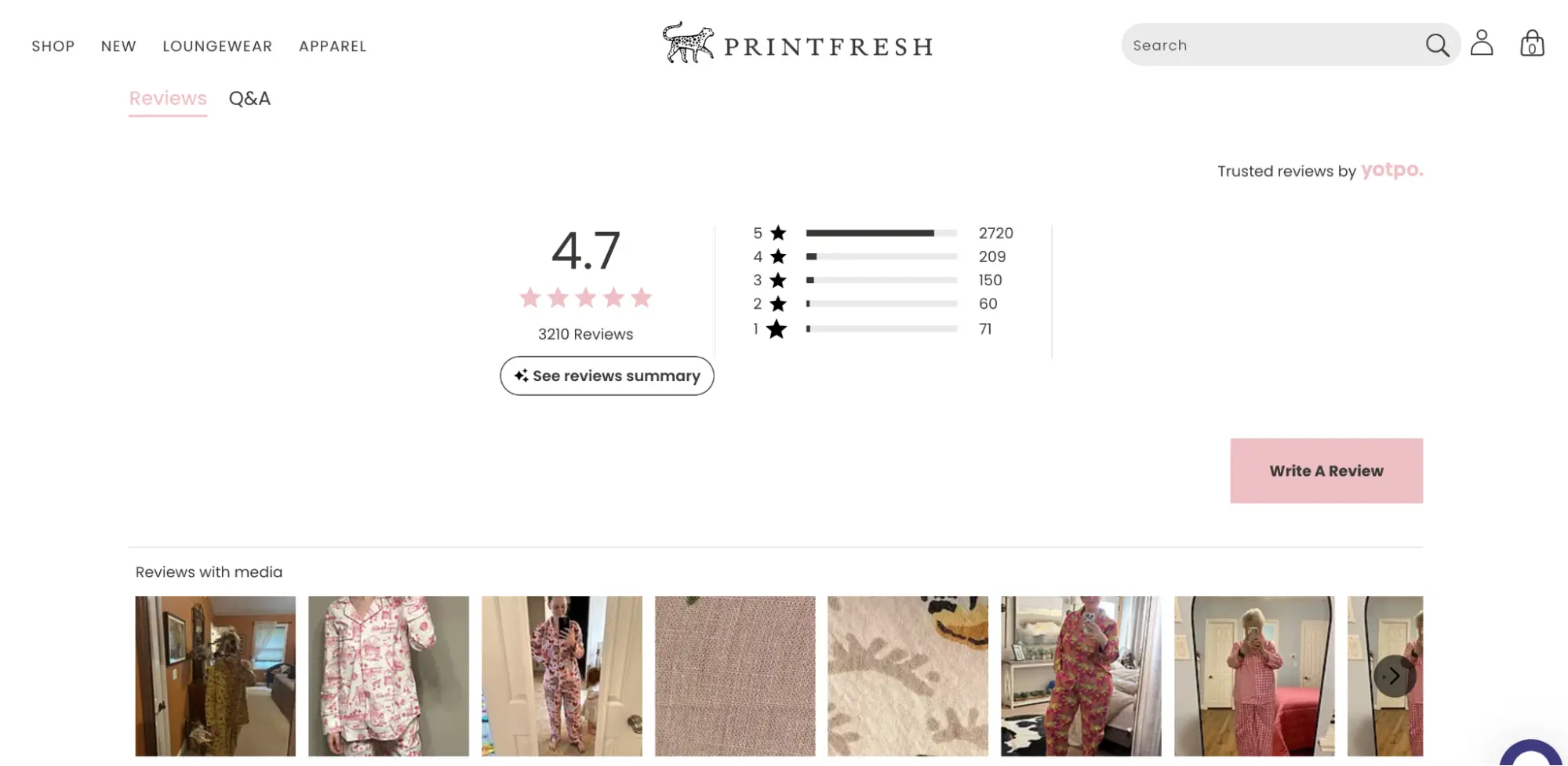
Many customers are happy to help, especially if they love the product.
Photos and videos go even further.
Encourage customers to share how they use your product in real life.
For a clothing brand, this might be a mirror selfie before a night out. For a cookware company, it could be a home chef showing off their latest dish.
When you repost these moments (with permission), it creates a feedback loop. Other customers see the recognition and want to join in.
There’s another layer to this. UGC doesn’t just help you rank. It helps people trust you. Social proof lowers buyer hesitation. It tells shoppers, “People like me have tried this—and it worked.”
Even negative reviews can help. A well-written 3-star review shows you’re not filtering feedback. It makes your 5-star reviews more believable.
Keep It Authentic
The best UGC isn’t polished. It’s not staged. It’s real. That’s what makes it powerful.
Encourage it. Highlight it. But don’t try to control it too much.
The more your customers feel like their voices matter, the more they’ll share, and the more credibility your brand earns in return.
Advanced Ecommerce SEO Strategies
Once you’ve implemented the fundamentals, you’re in a solid position. But to truly compete and grow, especially at scale, you’ll need to move beyond the basics.
Advanced ecommerce SEO is where strategy meets systems.
It’s about building a site that can handle hundreds (or thousands) of SKUs without breaking. That means automating key processes, expanding your keyword footprint with precision, and architecting your site in a way that supports both discovery and conversions.
In the sections below, we’ll explore the tactics that leading ecommerce brands use to expand their organic footprint.
SEO for Different Ecommerce Platforms
Not all ecommerce platforms are built equally when it comes to SEO.
Shopify, WooCommerce, Magento, and BigCommerce each come with built-in limitations, quirks, and opportunities.
Understanding these platform-specific challenges and developing systems to work around them is the basis of moving away from foundational SEO.
Let’s take a look at a few common scenarios and how to address them:
Shopify: Streamline Duplication and Tag-Based Pages
Shopify’s default URL structure can lead to duplicate content issues, particularly when product pages exist at both /products/ and /collections/ URLs.
Solution: Set canonical tags to your main product URL. This tells Google which version to index, helping you avoid dilution.
But don’t stop there. Shopify’s tag-based collections can be turned into high-intent landing pages. For example, if you sell dresses, you can create filtered collections like:
- /collections/dresses?constraint=bridal → Bridal Dresses
- /collections/dresses?constraint=petite → Petite Dresses
With some customization, you can add unique headers and intro content to each, giving you more pages to rank, without bloating your site.
Our full Shopify SEO checklist outlines every ecommerce seo tip in detail.
WooCommerce: Performance and Plugin Discipline
WooCommerce offers greater flexibility, but it comes with higher maintenance overhead.
Plugins like Yoast or Rank Math give you granular SEO control, but too many can slow down large stores.
Solution: Audit your plugin stack regularly. Use caching tools, CDNs, and lean, well-coded themes. Keep permalinks clean (/product-name/) and ensure your category/archive pages have rich content and metadata.
Magento / BigCommerce: Lean Into Structured Data
Platforms like Magento and BigCommerce offer enterprise-grade SEO features, but require more technical oversight. Schema markup, in particular, can make or break visibility in search.
Solution: Work with a developer or SEO plugin to ensure all product, review, and breadcrumb schema is implemented cleanly. Use Google’s Rich Results Test to validate output regularly.
Pro Ecommerce SEO tip: Whichever platform you use, keep a running SOP or SEO checklist for known issues and fixes. This lets you scale your optimizations across multiple stores or clients, without starting from scratch every time.
Programmatic Page Creation at Scale
When your product catalog grows beyond a few dozen items, manual optimization becomes inefficient.
That’s where programmatic SEO comes in.
This strategy helps you create hundreds (or thousands) of search-optimized pages using structured data, templates, and automation.
Done right, it helps you dominate long-tail keywords with high purchase intent, without sacrificing quality or relevance.
Let’s say you sell sleepwear and you have 200+ SKUs.
Instead of optimizing each product individually, you could generate high-intent collection or landing pages based on product tags like:
- Fabric: “Cotton Pajama Sets,” “Satin Sleepwear,” “Linen Nightgowns”
- Use case: “Bridal Pajamas,” “Maternity Pajamas,” “Vacation Sleepwear”
- Fit: “Petite Pajamas,” “Tall Sleepwear,” “Plus Size Pajama Sets”
Each page has a unique H1, meta title, description, and intro paragraph, automatically pulled from your product data and optimized for SEO.
These pages capture search terms with high intent that your main category structure would otherwise miss.
How to Execute Programmatic SEO
Programmatic SEO helps you scale without sacrificing relevance, but only if it’s done thoughtfully.
Here’s how to get it right:
Start by looking at your product data.
What attributes do your items already have, such as fabric, fit, use case, or style? These can become building blocks for SEO-friendly pages.
For example, tags like “bridal,” “satin,” or “petite” can be combined to create pages like satin bridal robes or petite cotton pajamas.
Once you have potential combinations, run them through a keyword tool to see what people are actually searching for. Prioritize terms that show buying intent and enough search volume to matter.
Next, build a dynamic template that can generate these pages at scale. You’ll want to include a custom H1, meta title, short intro paragraph, product grid, and optional FAQ or reviews. Whether you’re using Shopify, a headless CMS, or another setup, the goal is to make each page feel useful.
Before going all-in, test a small batch, say 20 to 50 pages.
Make sure they’re indexed, unique, and getting some traction. If they’re working, roll out more in phases and keep an eye on performance in Search Console.
And most importantly: don’t create pages just because you can. Only publish what people are actually searching for, and always aim to make the experience helpful.
Local SEO for Ecommerce
Local SEO isn’t just for brick-and-mortar stores. Even if you sell exclusively online, it still matters.
If you ship from a warehouse, run a studio, or serve a specific region, local search can help people find you. It’s also a great way to build trust and stand out in competitive markets.
Showing up in the map pack or for “near me” searches can drive highly targeted traffic.
Local SEO Essentials to Implement
Getting started with local SEO doesn’t require a massive overhaul.
Instead, a few key actions can make a big difference in how your store appears in local search.
First, claim and optimize your Google Business Profile. Add accurate business details, hours of operation, product categories, and a few high-quality photos.
This listing is often the first thing customers see in the map pack, and it builds credibility with both users and search engines.
Next, make sure your site includes local schema markup. This structured data helps search engines understand your business location and offerings.
It’s especially useful for highlighting your store’s physical presence or fulfillment center.
You’ll also want to build local citations, consistent listings of your business across directories like:
- Yelp
- Better Business Bureau (BBB)
- Industry-specific directories related to your niche
These citations reinforce your brand’s legitimacy and can improve your chances of ranking in local results.
Together, these steps create a strong foundation that helps search engines understand where you are and what you offer.
Create Locally Relevant Content
Local SEO involves creating content that resonates with people in specific regions.
Think about what your customers might search for beyond just your products.
If you’re based in Toronto and sell organic bedding, you could write a blog post like “Best Organic Bedding Options in the GTA”.
Or if you run a fitness apparel brand in California, consider a guide to “Top Running Trails and Gear in Los Angeles.”
This kind of content not only supports your SEO strategy but also builds trust by showing you understand your customers’ local needs.
Here are a few content ideas to help drive local traffic:
- “Best Of” guides tied to your niche and region (e.g., Best Maternity Pajamas in Chicago)
- Store locator or stockist pages for in-person availability
- FAQ pages that address region-specific topics like shipping timelines, return policies, or local taxes
Even if you don’t have a storefront, creating localized content can help your ecommerce store rank for valuable regional keywords.
Optimizing Your Online Store Starts with the Right Partner
Managing an ecommerce SEO strategy while juggling the demands of your business is no small task.
But you don’t have to do it alone.
At Digital Commerce Partners, we specialize in helping ecommerce brands grow through strategic, search-driven content and technical SEO that gets results.
From site audits to keyword mapping to long-term content execution, we handle the heavy lifting so you can stay focused on what you do best: running your store.
Check out our Ecommerce SEO Services page to learn how we can help you build a scalable SEO strategy that drives traffic, optimizes product rankings, and delivers long-term growth.

